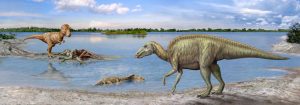
Our ancestors evolved three times faster in the 10 million years after the extinction of the dinosaurs than in the previous 80 million years, according to UCL researchers.
The team found the speed of evolution of placental mammals—a group that today includes nearly 5000 species including humans—was constant before the extinction event but exploded after, resulting in the varied groups of mammals we see today.
Lead researcher, Dr Thomas Halliday (UCL Genetics, Evolution & Environment), said: “Our ancestors—the early placental mammals – benefitted from the extinction of non-avian dinosaurs and dwindling numbers of competing groups of mammals. Once the pressure was off, placental mammals suddenly evolved rapidly into new forms.
“In particular, we found a group called Laurasiatheria quickly increased their body size and ecological diversity, setting them on a path that would result in a modern group containing mammals as diverse as bats, cats, rhinos, whales, cows, pangolins, shrews and hedgehogs.”
The team found that the last common ancestor for all placental mammals lived in the late Cretaceous period, about three million years before the non-avian dinosaurs became extinct 66 million years ago. This date is 20 million years younger than suggestions from previous studies which used molecular data from living mammals and assumed a near-constant rate of evolution.
In this study, funded by the Natural Environment Research Council and published today in Proceedings B of the Royal Society, the researchers analysed fossils from the Cretaceous to the present day, and used the dates of their occurrence in the fossil record to estimate the timing of divergences based on an updated tree of life. The new tree was released by the same team in 2015 and has the largest representation of Paleocene mammals to date.
The scientists measured all the small changes in the bones and teeth of 904 placental fossils and mapped the anatomical differences between species on the tree of life. From measuring the number of character changes over time for each branch, they found the average rate of evolution for early placental mammals both before and after the dinosaur extinction event. They compared the average rate of evolution over the geological stages before the extinction and the geological stages after to see what impact it had.
Senior author, Professor Anjali Goswami (UCL Genetics, Evolution & Environment and UCL Earth Sciences), said: “Our findings refute those of other studies which overlooked the fossils of placental mammals present around the last mass extinction. Using rigorous methods, we’ve successfully tracked the evolution of early placental mammals and reconstructed how it changed over time. While the rate differed between species, we see a clear and massive spike in the rates of evolution straight after the dinosaurs become extinct, suggesting our ancestors greatly benefitted from the demise of the dinosaurs. The huge impact of the dinosaur extinction on the evolution of our ancestors really shows how important this event was in shaping the modern world.”
Professor Paul Upchurch (UCL Earth Sciences), co-author of the study, added: “Our large and refined data set allows us to build a clearer picture of evolutionary history. We plan on using it to study other large-scale evolutionary patterns such as how early placental mammals dispersed across the continents via land bridges that no longer exist today.”
Reference:
Eutherians experienced elevated evolutionary rates in the immediate aftermath of the K-Pg mass extinction, Proceedings of the Royal Society B, DOI: 10.1098/rspb.2015.3026
Note: The above post is reprinted from materials provided by University College London.










